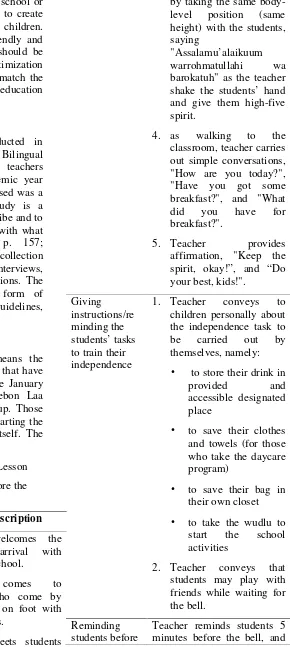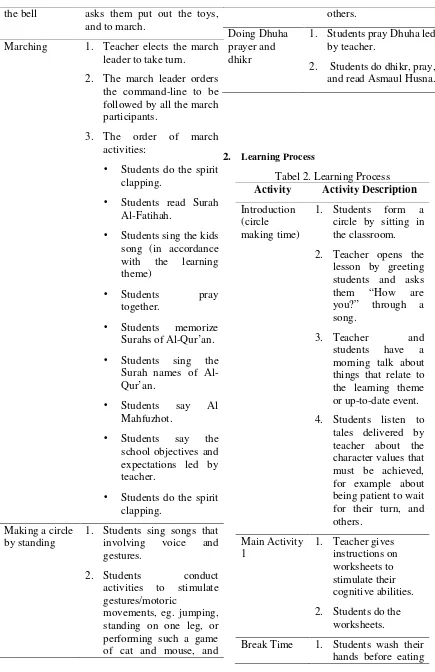A FRIENDLY AND FUN LEARNING DESIGN: STIMULATING PHASES OF
CHILDREN GROWTH DEVELOPMENT OPTIMALLY
1
Aliet Noorhayati Sutisno,2Cucu Suharti
1,2
Laa Tahzan Islamic Bilingual School
[email protected], [email protected]
Abstract
A friendly and fun learning is a very important aspect to achieve learning goals, especially in early childhood education that refers to the stages of child development. A fun learning design can be done by various methods, but the thing that is absolutely necessary is an attempt to make the students feel comfortable with the school environment, including attachment (bonding) with the teacher. Being comfortable in the school environment, they can take part the learning process without fear, so that the learning process to stimulate their growth development phase can be done properly and optimally.
Key words: reception, positive perception, early childhood education
INTRODUCTION
In reality the conduction of early childhood education in the community is thriving, in accordance with the level of parents understanding about its importance that shall be given to children earlier. While the study conducted in early childhood education is about learning to build a foundation and to instill character values. Educators and parents are to be gentle and courteous to children at pre-school age or toddlers, because it is a big influence in the success of the educational process and is the subsequent formation of the children’s
personality (Al-Maghribi, 2004).
Instilling the character values in early childhood learning process is impossible to do when the children feel uncomfortable. These efforts should be carried out by teachers of early childhood education so that children feel comfortable following their teaching and learning activities. Teachers as learning technical implementator are expected to create a friendly and fun learning design, so that children can grow and develop in accordance with their development phase. As it stated and written on UU Number 20, 2003 on National Education System article 1 number 14 which states that "Early Childhood Education (ECD) is a development efforts
aimed at children from birth to the age of six years old, that are accomplished by providing
educative stimulus to assist the children’s
growth and development physically and mentally in order to have the readiness to enter further education".
The reception of students in the morning is done by teachers when they arrive at school will make them much appreciated and feel comfortable. In this case, when the student arrives at school of course the parents are not allowed to wait because if the student attended by his parents in the school, the target achievement of independence would be difficult to succeed. Therefore, teachers and parents must work together to create a conducive situation, including the moment since they arrive at school in the morning.
With homey-like concepts school or home-schooling it is also expected to create comfortable conditions for children. Supporting factors in creating friendly and fun learning design for children should be kept well to the stimulating optimization given to early childhood that can match the objectives of the early childhood education system nationwide.
RESEARCH METHODS
This research was conducted in Cirebon Laa Tahzan Islamic Bilingual Playgroup. The participants were teachers and students of the school academic year 2014/2015. The research method used was a descriptive study. Descriptive Study is a research method that seeks to describe and to interpret the object in accordance with what is observed (Sukardi, 2008, p. 157; Sukmadinata 2010, p.72). Data collection techniques used was interviews, documentary studies, and observations. The instruments used were in the form of interview guidelines, observation guidelines, and documentation guidelines.
RESULTS AND DISCUSSION
Results and discussion means the design of friendly and fun learning that have been used during the lessons since January 2014 to December 2015 in Cirebon Laa Tahzan Islamic Bilingual Playgroup. Those are the morning activities before starting the lesson, and the learning process itself. The detailed discussion is as follows:
[image:2.595.243.533.90.737.2]1. Morning Activities before the Lesson Table 1. Morning Activities before the
Lesson
Activity Activity Description
Students Welcoming
1. Teacher welcomes the
students’ arrival with
parents to school.
2. Teacher comes to students who come by vehicles or on foot with their parents.
3. Teacher greets students
by taking the same body-level position (same height) with the students, saying
"Assalamu’alaikuum
warrohmatullahi wa barokatuh" as the teacher
shake the students’ hand
and give them high-five spirit.
4. as walking to the classroom, teacher carries out simple conversations, "How are you today?", "Have you got some breakfast?", and "What did you have for breakfast?".
5. Teacher provides affirmation, "Keep the
spirit, okay!”, and “Do
your best, kids!".
Giving instructions/re minding the
students’ tasks
to train their independence
1. Teacher conveys to children personally about the independence task to be carried out by themselves, namely:
• to store their drink in provided and accessible designated place
• to save their clothes and towels (for those who take the daycare program)
• to save their bag in their own closet
• to take the wudlu to start the school activities
2. Teacher conveys that students may play with friends while waiting for the bell.
Reminding students before
the bell asks them put out the toys, and to march.
Marching 1. Teacher elects the march leader to take turn.
2. The march leader orders the command-line to be followed by all the march participants.
3. The order of march activities:
• Students do the spirit clapping.
• Students read Surah Al-Fatihah.
• Students sing the kids song (in accordance with the learning theme)
• Students pray together.
• Students memorize Surahs of Al-Qur’an.
• Students sing the Surah names of
Al-Qur’an.
• Students say Al Mahfuzhot.
• Students say the school objectives and expectations led by teacher.
• Students do the spirit clapping.
Making a circle by standing
1. Students sing songs that involving voice and gestures.
2. Students conduct activities to stimulate gestures/motoric
movements, eg. jumping, standing on one leg, or performing such a game of cat and mouse, and
others.
Doing Dhuha prayer and dhikr
1. Students pray Dhuha led by teacher.
2. Students do dhikr, pray, and read Asmaul Husna.
[image:3.595.86.521.78.750.2]2. Learning Process
Tabel 2. Learning Process
Activity Activity Description
Introduction (circle making time)
1. Students form a circle by sitting in the classroom.
2. Teacher opens the lesson by greeting students and asks
them “How are you?” through a
song.
3. Teacher and students have a morning talk about things that relate to the learning theme or up-to-date event.
4. Students listen to tales delivered by teacher about the character values that must be achieved, for example about being patient to wait for their turn, and others.
Main Activity 1
1. Teacher gives instructions on worksheets to stimulate their cognitive abilities.
2. Students do the worksheets.
snacks (snack time).
2. Students pray before eating snacks (snack time).
3. Students eat snacks (snack time).
4. Students pray after eating snacks.
5. Students brush their teeth.
6. Students play (indoor/outdoor). The traditional games at school, namely: congklak, rambatan,
hopscotch, gobag sodor, cublek-cublek suweng, archery, etc.
Main Activity 2
1. Teacher delivers English bilingual lesson through songs.
2. Students and teacher have some games or quizzes about the bilingual lesson materials.
3. Students watch the bilingual lesson video based on the theme.
Having Lunch
1. Students wash their hands before lunch.
2. Teacher tries to motivate students to eat their meals by themselves and clean the dishes after that.
3. Students pray before meals, led by teacher.
4. Students have
lunch, and for students who have not been able to do, they will be guided by teachers.
5. Students pray after meals.
6. Students brush their teeth.
Doing Dhuhur Prayer
1. Students take wudlu before praying Dhuhur.
2. Students do dhuhur prayer guided by teacher.
Closing 1. Students with
teacher make the learning conclusion that has been implemented.
2. Students reflect the activities by answering questions from teacher.
3. Students pray before going home.
STUDENTS WELCOMING
A student welcoming is the moment
at school. Homey school concepts that exist in Cirebon Laa Tahzan Islamic Bilingual Playgroup are a deliberate design, so that students can still bring the warm atmosphere feeling of home. In welcoming students, of course, teachers must come earlier to school. So that, when the students arrive at school, the teachers are ready to welcome them. In addition, in this reception, the teachers should come to students who came with their parents. The point of this student’s reception
in the morning is in order to create a strong bond between students and teachers, and is expected to create a comfortable feeling toward school and learning process to be done.
POSITIVE PERCEPTIONS
The positive perception of early childhood students to school will bring a positive attitude toward school and all activities in it. This positive perception does not merely come in a sudden, it needs to be designed and created by teachers and parents.
The students’ background before entering school, especially for those that most of them are previously only familiar with their own family members and home environment is a factor that we should find a solution about, so that the students feel that the new environment at the school provides the same comfortable feeling as well as when they are with their family. Positive perceptions of school must always be nurtured through collaboration between parents and teachers. Because in early childhood education, the role of parents is still needed for the success of the learning objectives.
When a student comes to school with a perception that the school, the teachers, and the friends are, it will create an impact on their observed behavior in following the learning activities at school. Students will feel safe and comfortable at school as they are at home with their parents.
CONCLUSION AND SUGGESTION
Friendly and fun learning in early childhood is a necessary condition to achieve the purpose of conducting early childhood education. It is the children growth and
development that are in accordance with their development phase and the character values instillation. Fun learning is done with the initial preparation step in the morning. Comfortable and conducive environment is a contributing factor to successful learning. Learning process design that is in accordance
with the student’s development through
songs and games will make them feel comfortable and are not burdened with the learning materials. Besides, the learning process that is implemented with habituation
and simple activities that train student’s
independence and other characters is expected to be achieved.
REFERENCES
Agustin, M. 2011.
Permasalahan Belajar
dan
Inovasi
Pembelajaran.
Bandung: Refika Aditama
Al Maghribi, Al-Maghribi bin as-Said
2004.
Begini
Seharusnya
Mendidik
Anak:
Panduan
Mendidik
Anak
Sejak
Masa
Kandungan
Hingga
Dewasa.
Jakarta: Darul Haq
Amstrong, T. 2003.
Setiap Anak Cerdas.
Jakarta. PT Gramedia Pustaka
Utama.
Depdiknas.
2006.
Kurikulum
2004
Standar
Kompetensi
Taman
Kanak-kanak 7 Raudjatul Athfal.
Jakarta: Depdiknas
Himpunan
Perundangan-undangan
Republik
Indonesia
tentang
Sistem
Pendidikan
Nasional
(SISDIKNAS) No. 20 Tahun
2003. Bandung: Nuansa Aulia
Mulyani, Sumantri Dan Nana Saodih.
2008.
Perklembangan Peserta
Didik.
Jakarta: Univ Terbuka
Noorhayati, Aliet Sutisno. 2015.
Telaah
Filsafat Pendidikan.
Yogyakarta:
K-Media
Ethics of Care and Educational.
In The Encyclopedia of Informal
Educational.
Sukmadinata, N. S. 2005.
Metode
Penelitian Pendidikan.
Bandung.
Remaja Rosdakarya
Susanto, Ahmad. 2005.
Perkembangan
Anak Usia Dini. Jakarta: Indeks.
On line Journal
Margaret Barrow, 2015. “Caring In Teaching: A Complicated
Relationship”. JET (The Journal Of

